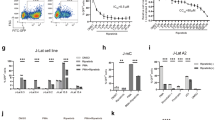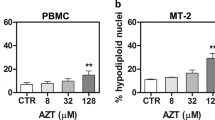Abstract
Human immunodeficiency virus (HIV) and hepatitis C virus (HCV) pose major public health concerns worldwide. HCV is clearly associated with the occurrence of hepatocellular carcinoma, and recently HIV infection has also been linked to the development of a multitude of cancers. Previously, we identified a novel nucleoside analog transcriptional inhibitor ARC (4-amino-6-hydrazino-7-β-D-ribofuranosyl-7H-pyrrolo[2,3-d]-pyrimidine-5-carboxamide) that exhibited proapoptotic and antiangiogenic properties in vitro. Here, we evaluated the effect of ARC on HIV-1 transcription and HCV replication. Using reporter assays, we found that ARC inhibited HIV-1 Tat-based transactivation in different cell systems. Also, using hepatoma cells that harbor subgenomic and full-length replicons of HCV, we found that ARC inhibited HCV replication. Together, our data indicate that ARC could be a promising candidate for the development of antiviral therapeutics against HIV and HCV.
This is a preview of subscription content, access via your institution
Access options
Subscribe to this journal
Receive 50 print issues and online access
$259.00 per year
only $5.18 per issue
Buy this article
- Purchase on Springer Link
- Instant access to full article PDF
Prices may be subject to local taxes which are calculated during checkout



Similar content being viewed by others
References
Ammosova T, Jerebtsova M, Beullens M, Lesage B, Jackson A, Kashanchi F et al. (2005). Nuclear targeting of protein phosphatase-1 by HIV-1 Tat protein. J Biol Chem 280: 36364–36371.
Ammosova T, Jerebtsova M, Beullens M, Voloshin Y, Ray PE, Kumar A et al. (2003). Nuclear protein phosphatase-1 regulates HIV-1 transcription. J Biol Chem 278: 32189–32194.
Bark-Jones SJ, Webb HM, West MJ . (2006). EBV EBNA 2 stimulates CDK9-dependent transcription and RNA polymerase II phosphorylation on serine 5. Oncogene 25: 1775–1785.
Berretta M, Cinelli R, Martellotta F, Spina M, Vaccher E, Tirelli U . (2003). Therapeutic approaches to AIDS-related malignancies. Oncogene 22: 6646–6659.
Bieniasz PD, Grdina TA, Bogerd HP, Cullen BR . (1998). Recruitment of a protein complex containing Tat and cyclin T1 to TAR governs the species specificity of HIV-1 Tat. EMBO J 17: 7056–7065.
Blight KJ, Kolykhalov AA, Rice CM . (2000). Efficient initiation of HCV RNA replication in cell culture. Science 290: 1972–1974.
Blight KJ, McKeating JA, Rice CM . (2002). Highly permissive cell lines for subgenomic and genomic hepatitis C virus RNA replication. J Virol 76: 13001–13014.
Brady J, Kashanchi F . (2005). Tat gets the ‘green’ light on transcription initiation. Retrovirology 2: 69.
Brigati C, Giacca M, Noonan DM, Albini A . (2003). HIV Tat, its TARgets and the control of viral gene expression. FEMS Microbiol Lett 220: 57–65.
Chao SH, Fujinaga K, Marion JE, Taube R, Sausville EA, Senderowicz AM et al. (2000). Flavopiridol inhibits P-TEFb and blocks HIV-1 replication. J Biol Chem 275: 28345–28348.
Deng L, Ammosova T, Pumfery A, Kashanchi F, Nekhai S . (2002). HIV-1 Tat interaction with RNA polymerase II C-terminal domain (CTD) and a dynamic association with CDK2 induce CTD phosphorylation and transcription from HIV-1 promoter. J Biol Chem 277: 33922–33929.
Garber ME, Wei P, Jones KA . (1998a). HIV-1 Tat interacts with cyclin T1 to direct the P-TEFb CTD kinase complex to TAR RNA. Cold Spring Harb Symp Quant Biol 63: 371–380.
Garber ME, Wei P, KewalRamani VN, Mayall TP, Herrmann CH, Rice AP et al. (1998b). The interaction between HIV-1 Tat and human cyclin T1 requires zinc and a critical cysteine residue that is not conserved in the murine CycT1 protein. Genes Dev 12: 3512–3527.
Giacca M . (2004). The HIV-1 Tat protein: a multifaceted target for novel therapeutic opportunities. Curr Drug Targets Immune Endocr Metabol Disord 4: 277–285.
Herrmann CH, Rice AP . (1995). Lentivirus Tat proteins specifically associate with a cellular protein kinase, TAK, that hyperphosphorylates the carboxyl-terminal domain of the large subunit of RNA polymerase II: candidate for a Tat cofactor. J Virol 69: 1612–1620.
Lau JY, Tam RC, Liang TJ, Hong Z . (2002). Mechanism of action of ribavirin in the combination treatment of chronic HCV infection. Hepatology 35: 1002–1009.
Levrero M . (2006). Viral hepatitis and liver cancer: the case of hepatitis C. Oncogene 25: 3834–3847.
Liang C, Wainberg MA . (2002). The role of Tat in HIV-1 replication: an activator and/or a suppressor? AIDS Rev 4: 41–49.
Liang TJ, Heller T . (2004). Pathogenesis of hepatitis C-associated hepatocellular carcinoma. Gastroenterology 127: S62–S71.
Lohmann V, Korner F, Koch J, Herian U, Theilmann L, Bartenschlager R . (1999). Replication of subgenomic hepatitis C virus RNAs in a hepatoma cell line. Science 285: 110–113.
MacCallum DE, Melville J, Frame S, Watt K, Anderson S, Gianella-Borradori A et al. (2005). Seliciclib (CYC202, R-Roscovitine) induces cell death in multiple myeloma cells by inhibition of RNA polymerase II-dependent transcription and down-regulation of Mcl-1. Cancer Res 65: 5399–5407.
Marcello A, Zoppe M, Giacca M . (2001). Multiple modes of transcriptional regulation by the HIV-1 Tat transactivator. IUBMB Life 51: 175–181.
Nekhai S, Bottaro DP, Woldehawariat G, Spellerberg A, Petryshyn R . (2000). A cell-permeable peptide inhibits activation of PKR and enhances cell proliferation. Peptides 21: 1449–1456.
Petryshyn R, Rosa F, Fagard R, Levin D, London IM . (1984). Control of protein synthesis in human reticulocytes by heme-regulated and double-stranded RNA dependent eIF-2 alpha kinases. Biochem Biophys Res Commun 119: 891–899.
Radhakrishnan SK, Bhat UG, Hughes DE, Wang IC, Costa RH, Gartel AL . (2006). Identification of a chemical inhibitor of the oncogenic transcription factor forkhead box M1. Cancer Res 66: 9731–9735.
Radhakrishnan SK, Gartel AL . (2006). A novel transcriptional inhibitor induces apoptosis in tumor cells and exhibits antiangiogenic activity. Cancer Res 66: 3264–3270.
Radhakrishnan SK, Layden TJ, Gartel AL . (2004). RNA interference as a new strategy against viral hepatitis. Virology 323: 173–181.
Roden R, Wu T-C . (2006). How will HPV vaccines affect cervical cancer? Nat Rev Cancer 6: 753–763.
Sano M, Abdellatif M, Oh H, Xie M, Bagella L, Giordano A et al. (2002). Activation and function of cyclin T-Cdk9 (positive transcription elongation factor-b) in cardiac muscle-cell hypertrophy. Nat Med 8: 1310–1317.
Sobell HM . (1985). Actinomycin and DNA transcription. Proc Natl Acad Sci USA 82: 5328–5331.
Tamrakar S, Kapasi AJ, Spector DH . (2005). Human cytomegalovirus infection induces specific hyperphosphorylation of the carboxyl-terminal domain of the large subunit of RNA polymerase II that is associated with changes in the abundance, activity, and localization of cdk9 and cdk7. J Virol 79: 15477–15493.
Wang D, de la Fuente C, Deng L, Wang L, Zilberman I, Eadie C et al. (2001). Inhibition of human immunodeficiency virus type 1 transcription by chemical cyclin-dependent kinase inhibitors. J Virol 75: 7266–7279.
Wei P, Garber ME, Fang SM, Fischer WH, Jones KA . (1998). A novel CDK9-associated C-type cyclin interacts directly with HIV-1 Tat and mediates its high-affinity, loop-specific binding to TAR RNA. Cell 92: 451–462.
Zhou M, Lu H, Park H, Wilson-Chiru J, Linton R, Brady JN . (2006). Tax interacts with P-TEFb in a novel manner to stimulate human T-lymphotropic virus type 1 transcription. J Virol 80: 4781–4791.
Acknowledgements
We thank Dr Charles Rice (Rockefeller University, NY, USA) for providing the hepatoma cell lines with the subgenomic and the full-length replicons of HCV. This work was supported by the 2006 Penny Severns award from IDPH (to ALG), start-up funds from the UIC Department of Medicine (to ALG), NIH Research Grant UH1HL 03679 funded by the National Heart, Lung, and Blood Institute and The Office of Research on Minority Health (to SN) and by NIH Grant R21 AI 156973-01 (to SN). We thank Dr Patricio Ray (Children's National Medical Center, Washington, DC, USA) for the gift of Adeno-Tat and Dr Michael Schneider (Baylor College of Medicine, TX, USA) for the gift of Adeno-dnCDK9.
Author information
Authors and Affiliations
Corresponding authors
Rights and permissions
About this article
Cite this article
Nekhai, S., Bhat, U., Ammosova, T. et al. A novel anticancer agent ARC antagonizes HIV-1 and HCV. Oncogene 26, 3899–3903 (2007). https://doi.org/10.1038/sj.onc.1210158
Received:
Revised:
Accepted:
Published:
Issue Date:
DOI: https://doi.org/10.1038/sj.onc.1210158
Keywords
This article is cited by
-
Advances in the development of nucleoside and nucleotide analogues for cancer and viral diseases
Nature Reviews Drug Discovery (2013)
-
ARC (NSC 188491) has identical activity to Sangivamycin (NSC 65346) including inhibition of both P-TEFb and PKC
BMC Cancer (2009)



